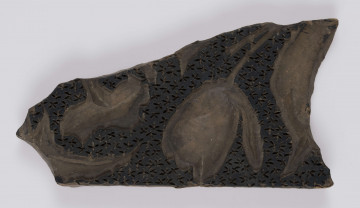
Block for printing on textile
1901 — 1950
National Museum in Lublin
Part of the collection: Fabric printing matrices
Textile printing stamps are wooden blocks used for the imprinting of designs onto fabrics by hand. Printed textiles used to be very popular, partly because they convincingly imitated expensive satins, brocades, and velvets, which were inaccessible to many. The presented stamp, shaped like a long narrow rectangle, was used to decorate the edges of the fabric. The block is covered with an elaborate floral ornament, made entirely of copper pins and thin plates stuck into wood. The intricate pattern, arranged in stripes, consists of a rhythmically repeating motif of a large, multi-petaled flower and a group of twigs with leaves. Below the pattern, there are two parallel rows of pins, whose task was to bring out the edge of the fabric. Such elements distinguished the stamps for imprinting edge patterns from the very similar blocks used for printing stripes. The stamp was used for decorating fabrics with the batik printing technique. Covered with an insulating paste, the so-called resist, the pattern was imprinted on the fabric, which was then soaked in dye and dried. After removing the resist, the pattern in the natural colour of the fabric was visible on the dyed background. The technique of batik printing has been known for centuries, but it only became widespread in Europe in the 17th century.
Author / creator
Dimensions
cały obiekt: height: 5,7 cm, width: 30 cm
Object type
matrix
Creation time / dating
Creation / finding place
Identification number
Location / status

1901 — 1950
National Museum in Lublin

1901 — 1950
National Museum in Lublin

1901 — 1950
National Museum in Lublin
DISCOVER this TOPIC
Museum of King Jan III's Palace at Wilanów
DISCOVER this PATH
Educational path